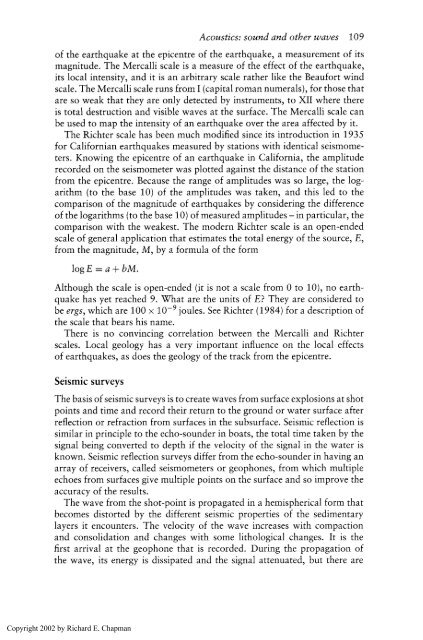Physics for Geologists, Second edition
Physics for Geologists, Second edition
Physics for Geologists, Second edition
Create successful ePaper yourself
Turn your PDF publications into a flip-book with our unique Google optimized e-Paper software.
Acoustics: sound and other waves 109<br />
of the earthquake at the epicentre of the earthquake, a measurement of its<br />
magnitude. The Mercalli scale is a measure of the effect of the earthquake,<br />
its local intensity, and it is an arbitrary scale rather like the Beau<strong>for</strong>t wind<br />
scale. The Mercalli scale runs from I (capital roman numerals), <strong>for</strong> those that<br />
are so weak that they are only detected by instruments, to XI1 where there<br />
is total destruction and visible waves at the surface. The Mercalli scale can<br />
be used to map the intensity of an earthquake over the area affected by it.<br />
The Richter scale has been much modified since its introduction in 1935<br />
<strong>for</strong> Cali<strong>for</strong>nian earthquakes measured by stations with identical seismome-<br />
ters. Knowing the epicentre of an earthquake in Cali<strong>for</strong>nia, the amplitude<br />
recorded on the seismometer was plotted against the distance of the station<br />
from the epicentre. Because the range of amplitudes was so large, the log-<br />
arithm (to the base 10) of the amplitudes was taken, and this led to the<br />
comparison of the magnitude of earthquakes by considering the difference<br />
of the logarithms (to the base 10) of measured amplitudes - in particular, the<br />
comparison with the weakest. The modern Richter scale is an open-ended<br />
scale of general application that estimates the total energy of the source, E,<br />
from the magnitude, M, by a <strong>for</strong>mula of the <strong>for</strong>m<br />
Although the scale is open-ended (it is not a scale from 0 to lo), no earth-<br />
quake has yet reached 9. What are the units of E? They are considered to<br />
be ergs, which are 100 x lop9 joules. See Richter (1984) <strong>for</strong> a description of<br />
the scale that bears his name.<br />
There is no convincing correlation between the Mercalli and Richter<br />
scales. Local geology has a very important influence on the local effects<br />
of earthquakes, as does the geology of the track from the epicentre.<br />
Seismic surveys<br />
The basis of seismic surveys is to create waves from surface explosions at shot<br />
points and time and record their return to the ground or water surface after<br />
reflection or refraction from surfaces in the subsurface. Seismic reflection is<br />
similar in principle to the echo-sounder in boats, the total time taken by the<br />
signal being converted to depth if the velocity of the signal in the water is<br />
known. Seismic reflection surveys differ from the echo-sounder in having an<br />
array of receivers, called seismometers or geophones, from which multiple<br />
echoes from surfaces give multiple points on the surface and so improve the<br />
accuracy of the results.<br />
The wave from the shot-point is propagated in a hemispherical <strong>for</strong>m that<br />
becomes distorted by the different seismic properties of the sedimentary<br />
layers it encounters. The velocity of the wave increases with compaction<br />
and consolidation and changes with some lithological changes. It is the<br />
first arrival at the geophone that is recorded. During the propagation of<br />
the wave, its energy is dissipated and the signal attenuated, but there are<br />
Copyright 2002 by Richard E. Chapman






